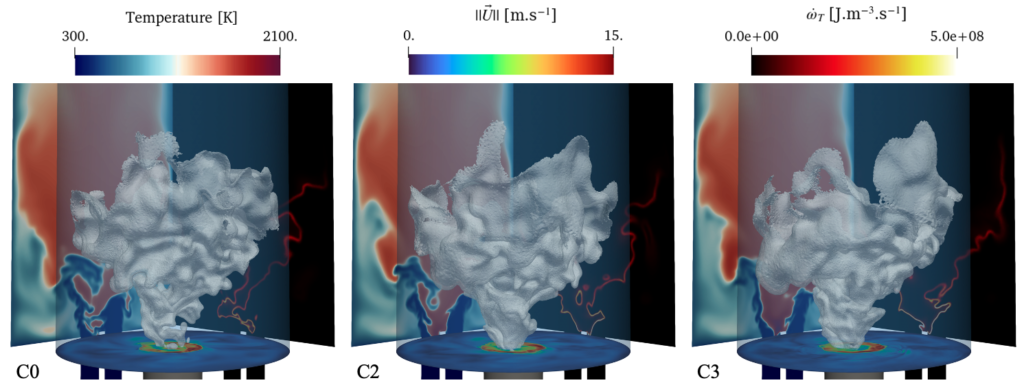Training | Computational Fluid Dynamics | Combustion, Computational Fluid Dynamics, Electromagnetism, High Performance Computing
Required Education : Master
Start date : 1 February 2024
Mission duration : 6 mois
Deadline for applications : 1 January 2024
Gratification : 650€/mois
Context
Today, it is crucial for our society to have access to a reliable energy source with a low impact on the environment and climate. In this context, projects are currently underway to use decarbonized fuels such as NH3 as an energy carrier. These fuels can be produced using intermittent energy sources (wind, solar, etc.), serving as a form of storage and can be used in a controlled manner. However, using ammonia in current combustion chambers is not immediately possible and requires an adaptation phase to meet safety and pollutant emission standards, such as NOx. To achieve this, it is natural to move towards lean combustion regimes, unfortunately prone to instabilities and more difficult to ignite. An emerging solution to these problems is to use nanosecond repetitively pulsed discharges. This type of discharge is known to be able to mitigate instabilities encountered in combustion chambers and is also effective for ignition, with low electrical power compared to that of the flame (≤1%).
NOx emissions resulting from ammonia combustion present a significant environmental concern, given their adverse effects on air quality and the overall climate. Despite being considered a zero-carbon fuel alternative, ammonia still generates NOx emissions when undergoing oxidation, contributing to smog formation and posing risks to human health. In response to this challenge, Non-Equilibrium Plasma (NEP) technology emerges as a promising solution. Recent works involving NEP discharges have shown substantial potential in reducing NOx levels during ammonia combustion [1]. This innovative approach modifies the combustion kinetics, disrupting the formation of nitrogen oxides, and offers precise control over the combustion process, resulting in cleaner and more efficient combustion. NEP technology thus offers a promising avenue for mitigating NOx emissions in ammonia combustion.
Mission
The primary objective of this internship is to gain a comprehensive understanding of the physics of non-equilibrium plasma discharges and their interplay with combustion processes. The fundamentals of plasma-assisted combustion rely on chemistry, which dictates kinetic and heat-related effects. To investigate this, the candidate will employ the Cantera software and its plasma extension [2] to conduct simulations of the ignition of an NH3-air mixture using a detailed kinetic mechanism. While recent research has provided a thorough examination of methane-air mixture ignition under similar conditions, the primary focus will be on adapting these methodologies to mixtures containing ammonia. Existing literature offers comprehensive kinetic mechanisms for Plasma-Assisted Ammonia Combustion (PAAC) [3], which will serve as the foundation for this research. Special attention will be given to an in-depth analysis of the key kinetic pathways in plasma-assisted ammonia combustion, utilising the analysis tools available in the ARCANE library [4]. Finally, reduced order model [5] will be used to study plasma-assisted ammonia ignition using the reactive compressible Navier-Stokes solver AVBP (https://www.cerfacs.fr/avbp7x/) based on prior work made on methane [6] (see Fig. 1). For that purpose, a simplified channel configuration will be used representative of the one used in [7]..

Work program
- Assimilation of the plasma discharge physics, including non-equilibrium chemistry. (litterature review).
- Kinetic analysis of plasma-assisted ammonia ignition using Cantera and Arcane to adapt reduced order model.
- Plasma-Assisted Ammonia Ignition simulation using AVBP.
Technical program
- Develop and improve pre-processing or post-processing scripts in Python.
- Carry out developments in the Fortran language within the AVBP code.
A doctoral position (ANR JETHPAC) is funded for September 2024, providing an opportunity for highly motivated candidates to continue to work in the field of plasma-assisted combustion.
Contacts
N. Barléon (barleon@cerfacs.fr)
B. Cuenot (cuenot@cerfacs.fr)
O. Vermorel (vermorel@cerfacs.fr)
[1] J. Choe, W. Sun, T. Ombrello, C. Carter, Plasma assisted ammonia combustion: Simultaneous NOx reduction and flame enhancement, Combustion and Flame 228 (2021) 430–432.
[2] L. Cheng, N. Barleon, B. Cuenot, O. Vermorel, A. Bourdon, Plasma assisted combustion of methane air mixtures: Validation and reduction, Combustion and Flame 240 (2022) 111990.
[3] M. Shahsavari, A. A. Konnov, A. Valera-Medina, M. Jangi, On nanosecond plasma-assisted ammonia combustion: Effects of pulse and mixture properties, Combustion and Flame 245 (2022) 112368.
[4] Q. Cazères, P. Pepiot, E. Riber, B. Cuenot, A fully automatic procedure for the analytical reduction of chemical kinetics mechanisms for computational fluid dynamics applications, Fuel 303 (2021) 121247.
[5] N. Barleon, L. Cheng, B. Cuenot, O. Vermorel, A phenomenological model for plasma-assisted combustion with NRP discharges in methane-air mixtures: PACMIND, Combustion and Flame 253 (2023) 112794.
[6] N. Barleon, B. Cuenot, O. Vermorel, Large-eddy simulation of swirled flame stabilisation using NRP discharges at atmospheric pressure, Applications in Energy and Combustion Science 15 (2023) 100163.
[7] J. K. Lefkowitz, S. D. Hammack, C. D. Carter, T. M. Ombrello, Elevated OH production from NPHFD and its effect on ignition, Proceedings of the Combustion Institute 38 (4) (2021) 6671–6678.

